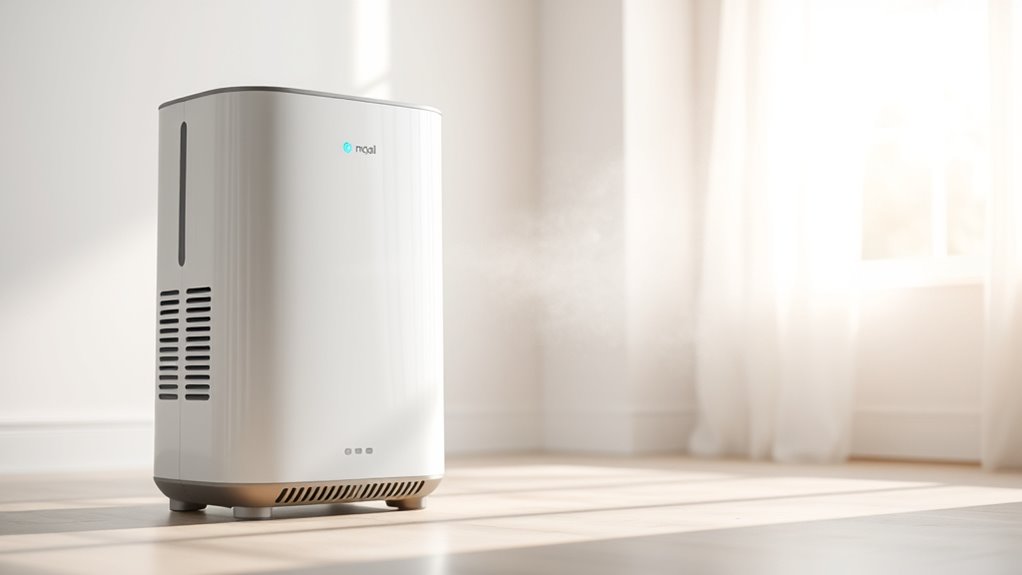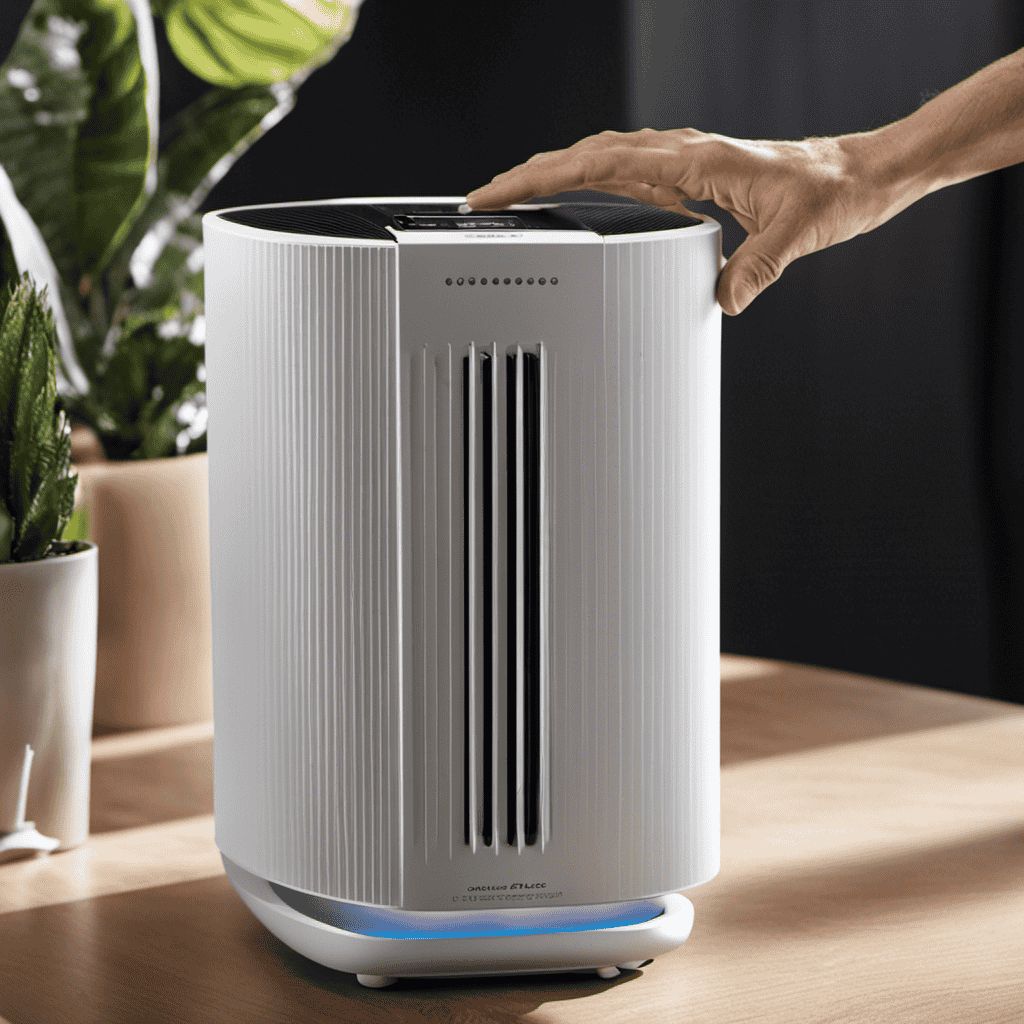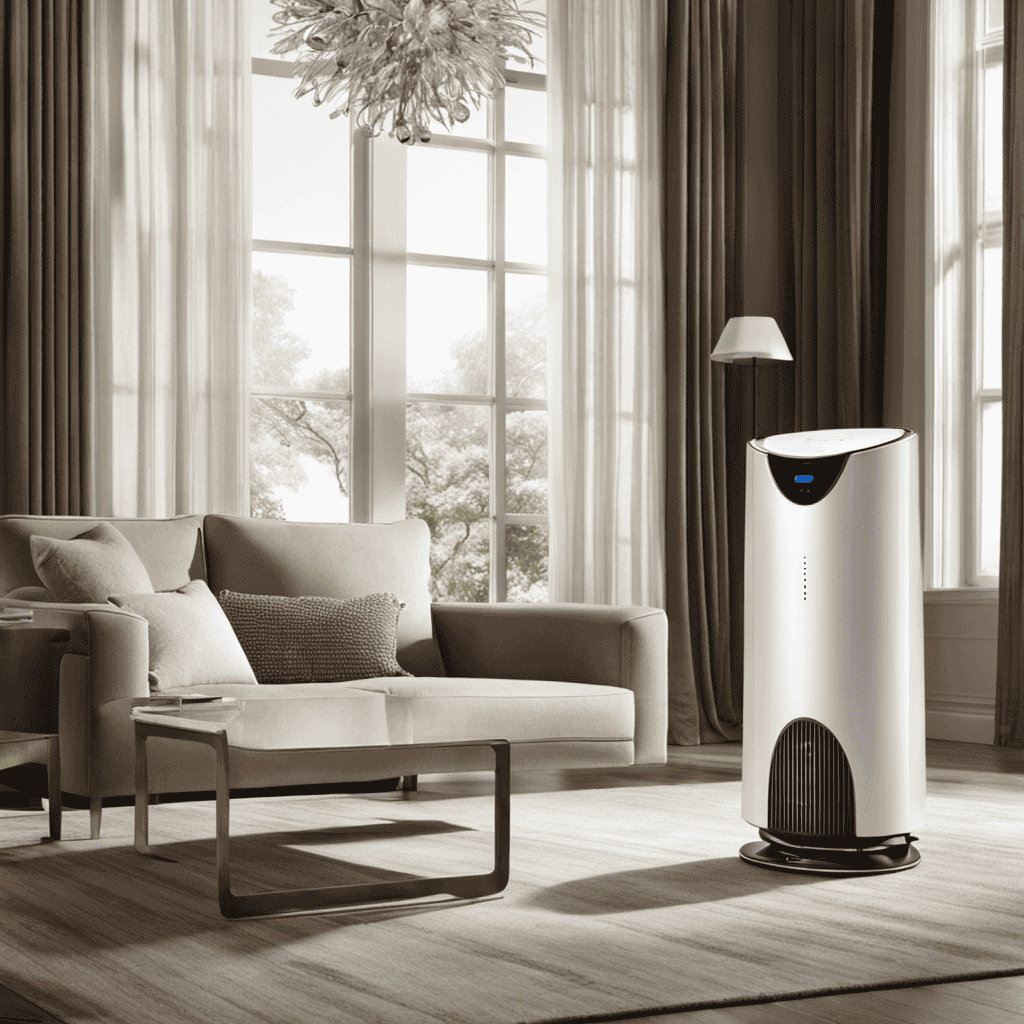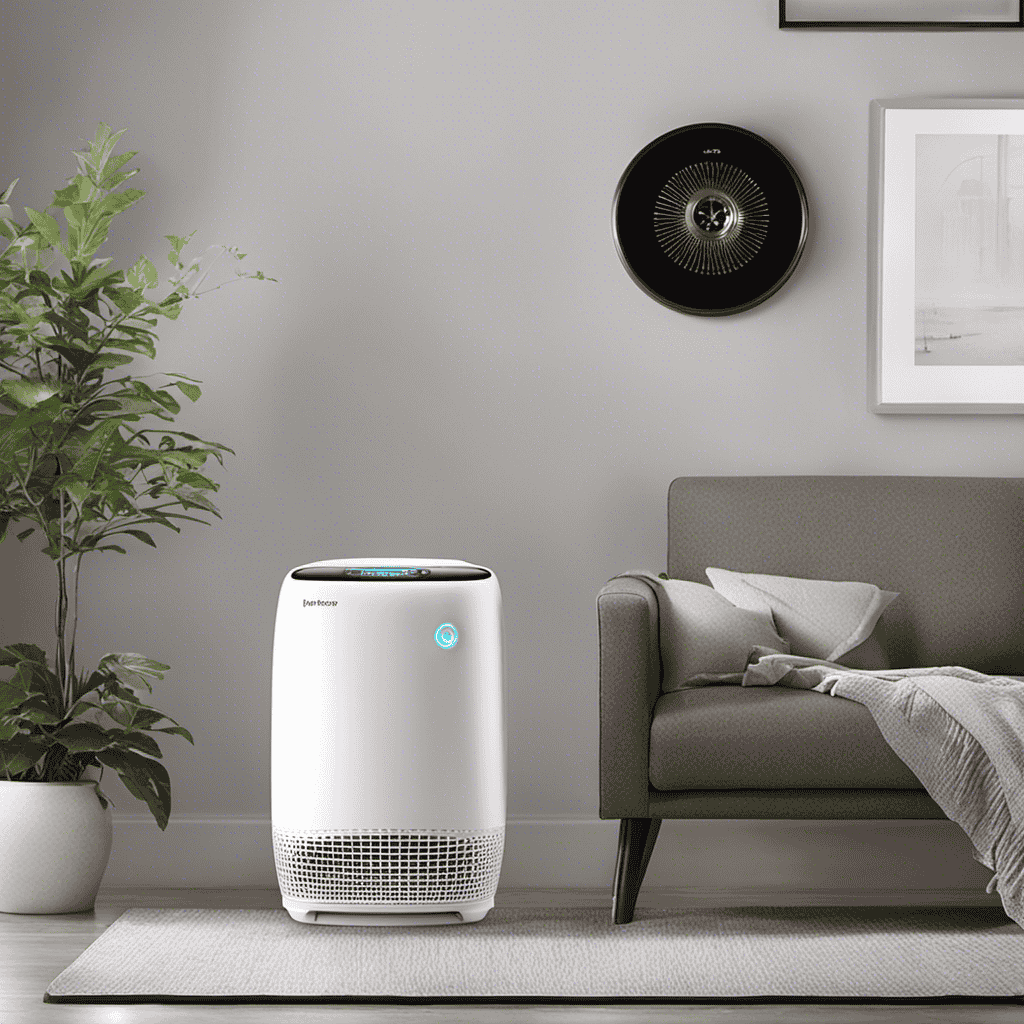PCO and PECO purifiers use photocatalytic oxidation to break down airborne pollutants like VOCs, bacteria, and odors, offering a continuous, chemical-free way to improve indoor air quality. PCO uses UV light and catalysts, but can create byproducts, while PECO applies electrical charges to destroy pollutants more safely. Understanding how these technologies work helps you choose the right purifier. If you want to learn more about how they actively clean your air, keep exploring further.
Key Takeaways
- PCO and PECO purifiers use UV light-activated catalysts to break down pollutants, bacteria, and VOCs at a molecular level.
- PCO may produce byproducts like ozone, while PECO applies electrical charges to destroy pollutants safely without harmful emissions.
- Both technologies offer continuous air purification, effectively reducing airborne contaminants and odors in indoor environments.
- Proper maintenance, including cleaning or replacing photocatalytic surfaces, is essential to sustain efficiency and safety.
- Selection depends on specific air quality needs, with PECO generally providing cleaner, more targeted pollutant removal without harmful byproducts.
What Are PCO and PECO Purifiers?
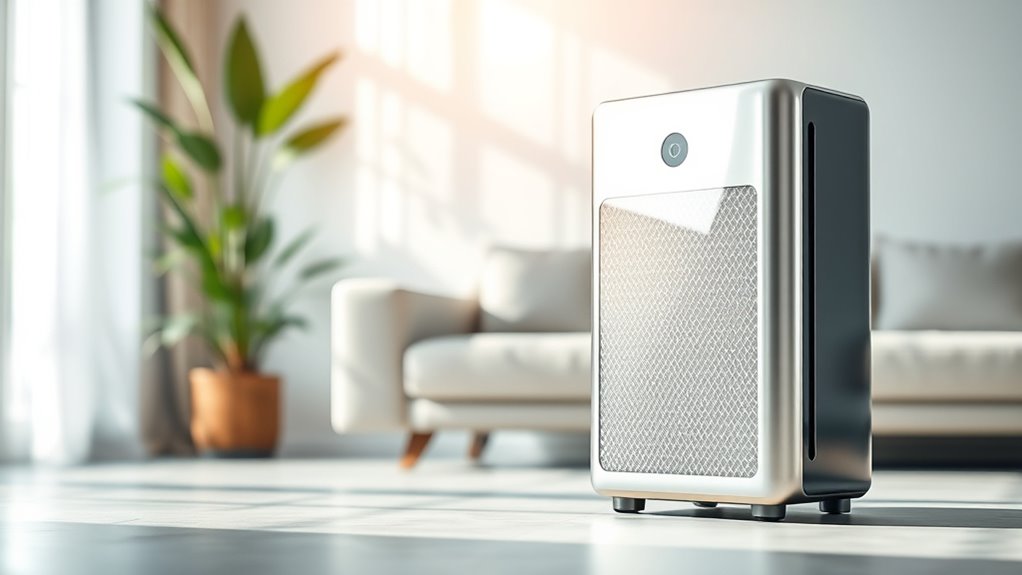
Have you ever wondered how air purifiers remove harmful microorganisms and pollutants? PCO (Photocatalytic Oxidation) and PECO (Photocatalytic Oxidation with advanced filter technology) purifiers use light-activated catalysts to break down pollutants at a molecular level. Unlike traditional filters, they don’t just trap particles—they neutralize bacteria, viruses, and VOCs. When considering air filter maintenance, these systems often require less frequent filter changes because they destroy contaminants rather than just trap them. A cost comparison shows that, although PCO and PECO purifiers may have higher upfront prices, their long-term savings come from reduced filter replacements and ongoing effectiveness. Additionally, these technologies are part of ongoing innovations in air purification technology, which aim to improve efficiency and safety. These features make them an appealing choice for those seeking a more thorough air cleaning solution, especially as air quality standards continue to evolve. Another benefit is that PCO and PECO systems are capable of destroying microorganisms that traditional filters might struggle to fully eliminate, making them ideal for sensitive environments. Moreover, the use of UV light activation enhances their ability to effectively neutralize a broader spectrum of airborne pollutants.
The Science Behind Photocatalytic Oxidation
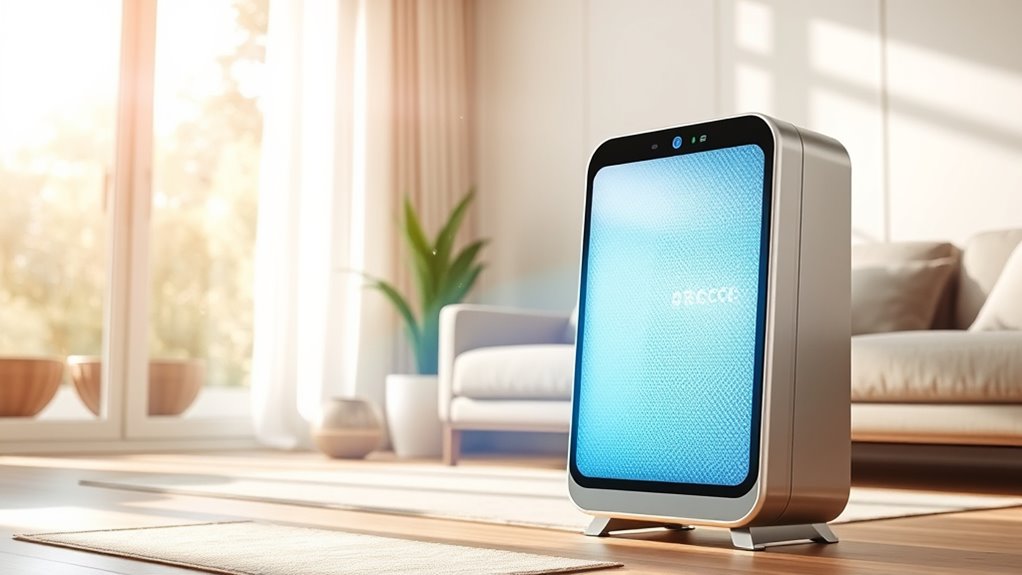
Photocatalytic oxidation works by using light-activated catalysts to break down pollutants. When exposed to UV light, the catalyst triggers chemical reactions that transform harmful particles into harmless substances like water and carbon dioxide. Understanding these reactions helps you see how PCO and PECO purifiers clean the air effectively. Regular maintenance and understanding performance upgrades can further optimize their efficiency and ensure continued air quality. Additionally, advancements in projector technology have improved the precision and effectiveness of photocatalytic processes.
How Photocatalysis Works
Photocatalytic oxidation relies on a special catalyst, usually titanium dioxide, that activates when exposed to light. When UV light hits the catalyst, it triggers catalyst activation, creating reactive species. These species then break down pollutants at a molecular level. Here’s how it works:
- UV light energizes the catalyst, exciting its electrons.
- This activation produces reactive oxygen species like hydroxyl radicals.
- These radicals attack and decompose volatile organic compounds (VOCs), bacteria, and odors.
- The process converts harmful pollutants into harmless substances like carbon dioxide and water.
- Incorporating dog-friendly policies in public spaces can also reduce pet-related odors and pollutants, complementing air purification efforts. Additionally, understanding the materials used in photocatalytic surfaces can improve their effectiveness and safety.
Chemical Reactions Involved
When UV light energizes the titanium dioxide catalyst, it causes electrons within the material to become excited, creating electron-hole pairs. These pairs initiate catalytic reactions on the surface, leading to oxidative processes that break down pollutants. The electrons reduce oxygen molecules to form reactive oxygen species, while the holes oxidize organic compounds and other contaminants. This combination drives powerful oxidative reactions that convert harmful substances like VOCs, bacteria, and viruses into harmless byproducts such as carbon dioxide and water. Understanding photocatalytic reactions is essential to grasp how these processes effectively eliminate pollutants. These catalytic reactions continuously occur as long as UV light is present, maintaining a clean environment. Recognizing the role of catalysts in these reactions helps you see how photocatalytic oxidation cleans the air efficiently by transforming pollutants into safe, less reactive compounds. Additionally, the thermal stability of the catalyst ensures consistent performance over time, even under varying environmental conditions. Furthermore, ongoing research into photocatalytic materials suggests potential improvements in efficiency and durability for air purifiers.
Key Components of Photocatalytic Air Cleaners
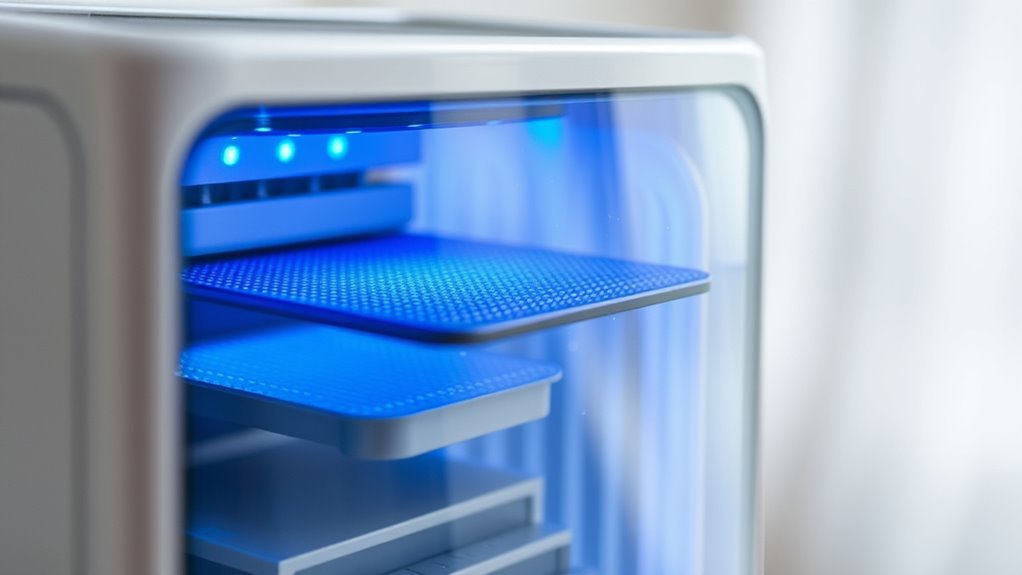
At the core of photocatalytic air cleaners are several essential components that work together to purify the air effectively. First, the UV light source provides the energy needed for photocatalyst activation, enabling chemical reactions to occur. Second, the photocatalyst itself, usually titanium dioxide, facilitates the breakdown of pollutants upon UV light interaction. Third, the filter housing holds these components securely and directs airflow through the system. Fourth, the fan ensures air moves steadily through the purifier, exposing pollutants to the activated photocatalyst. These components collaborate to generate reactive species that neutralize contaminants, making the air safer to breathe. Proper integration of these parts maximizes efficiency and guarantees consistent air purification performance. Additionally, understanding the security features of these systems can help ensure they operate safely and effectively over time. Recognizing the maintenance requirements of photocatalytic air purifiers is also essential to sustain optimal functionality and prolong the lifespan of the components.
Comparing PCO and PECO Technologies
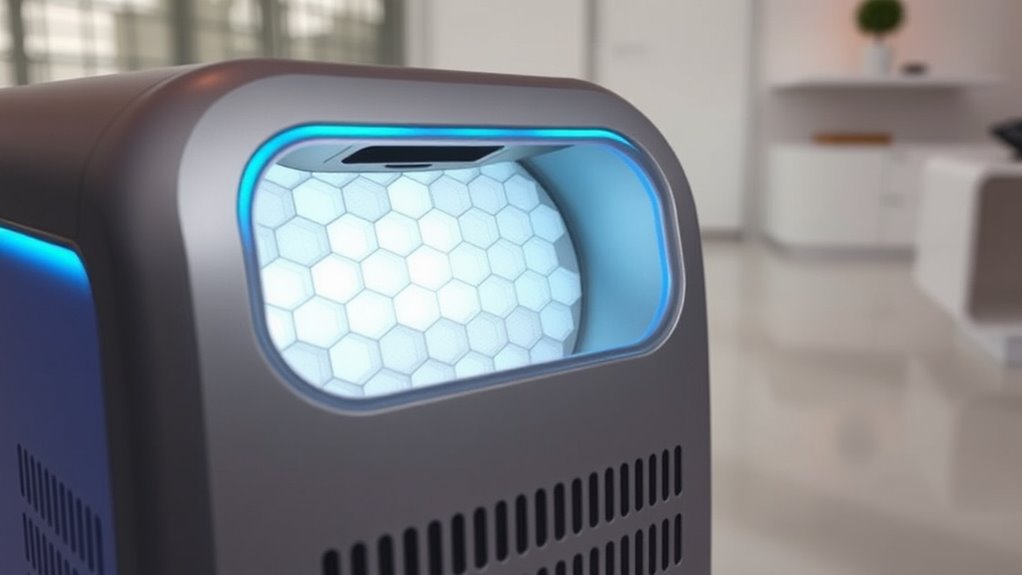
While both PCO (Photocatalytic Oxidation) and PECO (Photoelectrochemical Oxidation) technologies aim to purify indoor air, they differ markedly in how they neutralize pollutants. PCO uses UV light and a catalyst to oxidize contaminants, often creating by-products. PECO, however, applies an electrical charge, enabling it to destroy pollutants at a molecular level without producing harmful emissions. This distinction impacts their innovative applications and future developments. As AI advancements emphasize AI Safety and the importance of monitoring AI behavior, these principles highlight the need for rigorous safety measures in emerging technologies. Additionally, understanding pollutant neutralization mechanisms can help improve air purification systems’ safety and efficiency, especially when considering the safety of different purification methods. Moreover, advances in energy production from renewable sources like solar and wind can support the sustainable operation of these air purification systems.
Benefits of Using Photocatalytic Purifiers

Photocatalytic purifiers offer you effective air purification by breaking down pollutants at a molecular level. They rely on eco-friendly technology, using light and catalysts to clean the air without harmful chemicals. This process also reduces harmful pollutants, making your indoor environment safer and healthier. Additionally, integrating lifestyle practices such as maintaining a clean and organized space can further enhance air quality. Regular use of these purifiers can lead to sustained improvements in indoor air quality, especially when combined with good ventilation and cleanliness habits. Understanding HEPA filtration and other advanced technologies can help you select the most effective purifier for your needs. For example, understanding how airborne contaminants are filtered or neutralized can improve your choices and maintenance routines.
Effective Air Purification
Photocatalytic purifiers offer a highly effective way to improve indoor air quality by actively breaking down pollutants rather than merely trapping them. This technology enhances pollutant removal, resulting in cleaner, healthier air. Here are some key benefits:
- Comprehensive pollutant breakdown – destroys bacteria, viruses, and VOCs at a molecular level.
- Continuous air purification – works 24/7 without needing replacement filters.
- Reduces odors – neutralizes strong smells from pets, smoke, and cooking.
- Improves overall air quality – creates a safer environment for you and your family.
- Advanced filtration capabilities – many photocatalytic purifiers incorporate HEPA filters or other multi-stage systems to further enhance air cleaning efficiency.
Eco-Friendly Technology
Using photocatalytic purifiers is an environmentally friendly choice that benefits both your health and the planet. These devices support sustainable design by reducing reliance on disposable filters and minimizing waste. They operate efficiently with minimal energy consumption, often powered by renewable energy sources like solar or wind, making them a smart eco-conscious option. Unlike traditional air purifiers that may produce harmful byproducts, photocatalytic technology uses natural processes to break down pollutants, reducing environmental impact. Necessary cookies ensure the basic functionalities of these devices are maintained, further supporting their eco-friendly operation. By choosing these purifiers, you’re investing in a cleaner future while maintaining a healthier indoor environment. Their use of renewable energy and sustainable design principles ensures you’re contributing to long-term ecological balance, making them a responsible choice for eco-minded consumers. Additionally, advancements in spatial audio can enhance the user experience by creating more immersive environments, even when used in conjunction with eco-friendly devices. Incorporating air quality monitoring features can further optimize purifier performance, ensuring optimal indoor air conditions while adhering to environmentally conscious practices.
Reduces Harmful Pollutants
By harnessing natural processes to neutralize pollutants, photocatalytic purifiers substantially improve indoor air quality. They effectively target and reduce harmful airborne pollutants, making your environment safer. Here are four ways they help with pollutant reduction:
- Break down volatile organic compounds (VOCs) from paints and cleaners.
- Inactivate bacteria, viruses, and mold spores.
- Eliminate odors caused by cooking, pets, or smoke.
- Reduce airborne chemicals that can cause respiratory issues.
Using PCO or PECO technology, you enhance indoor air quality by actively destroying pollutants at a molecular level. This ongoing process ensures cleaner air, fewer allergens, and a healthier living or working space. Photocatalytic purifiers are a smart choice for maintaining a safer, pollutant-reduced environment.
Potential Limitations and Considerations

While PCO and PECO purifiers offer effective air cleaning, they also have some limitations you should consider. One key concern is long-term safety, as ongoing use might produce byproducts like ozone or other reactive compounds, which could impact indoor air quality if not properly managed. Additionally, these purifiers can present maintenance challenges; their photocatalytic surfaces need regular cleaning to maintain efficiency, and replacing filters or components can be necessary over time. If neglected, performance can decline, and potential safety risks may increase. It’s important to follow manufacturer guidelines for maintenance and monitor the purifier’s operation to ensure safety and effectiveness. Being aware of these limitations helps you make better decisions when considering photocatalytic air cleaning systems for your space.
Choosing the Right Air Purifier for Your Space

Choosing the right air purifier for your space involves understanding your specific air quality needs and the features that best address them. Consider these factors:
- Room size: Match the purifier’s capacity to your space to ensure effective air cleaning.
- Filtration type: For allergens or pollutants, opt for HEPA filters; for odors, activated carbon is ideal.
- Photocatalytic technology: PCO and PECO purifiers excel at breaking down VOCs and pathogens.
- Filter maintenance: Regularly changing or cleaning filters is essential to maintain ideal air quality and purifier performance.
Frequently Asked Questions
How Long Do Photocatalytic Purifiers Typically Last?
Photocatalytic purifiers usually last about 3 to 5 years, depending on their durability lifespan. You should expect some decline in efficiency over time, so regular maintenance is essential. Cleaning or replacing the catalyst can extend the device’s life. Keep in mind that proper maintenance frequency helps guarantee peak performance, allowing you to enjoy cleaner air longer without needing an early replacement.
Are PCO and PECO Purifiers Safe for Pets and Children?
You might wonder if PCO and PECO purifiers are safe for pets and children. These purifiers are generally safe when used properly, but it’s important to take into account pet safety and potential chemical emissions. Some units produce low levels of byproducts that could affect sensitive individuals. Always choose devices with proven safety standards, ensure proper ventilation, and follow manufacturer instructions to protect your family from any chemical emissions.
Can They Eliminate All Types of Airborne Viruses?
Did you know that some viruses are resistant to traditional filters? While PCO and PECO purifiers can substantially reduce airborne viruses, they can’t eliminate all types due to viral resistance and filtration limitations. These purifiers improve air quality but shouldn’t be solely relied upon for complete virus removal. Regular cleaning, ventilation, and other precautions remain essential for thorough protection against airborne pathogens.
How Energy-Efficient Are Photocatalytic Air Cleaners?
You might wonder about their energy consumption and cost efficiency. Photocatalytic air cleaners use moderate energy, balancing effective purification with reasonable power use. They are generally cost-efficient over time because they require minimal maintenance and have low ongoing energy needs. While they do consume electricity, their overall energy footprint remains manageable, making them a practical choice if you’re looking for an eco-friendly, budget-conscious way to improve indoor air quality.
Do These Purifiers Produce Any Harmful Byproducts?
Think of photocatalytic purifiers as a garden where pollutants are broken down by sunlight. While they effectively remove odors and chemicals, you should be aware of chemical emissions and ozone concerns. Some models may produce small amounts of harmful byproducts, so it’s essential to select devices with proper certifications. Always guarantee proper ventilation and maintenance to minimize potential risks from chemical emissions or ozone.
Conclusion
Considering PCO and PECO purifiers can considerably improve your air quality by neutralizing pollutants at a molecular level. Did you know that studies show photocatalytic air cleaning can reduce airborne bacteria and VOCs by up to 99%? This technology offers a powerful, eco-friendly way to create a healthier indoor environment. By understanding how these purifiers work, you can make smarter choices to protect your loved ones and breathe easier every day.
